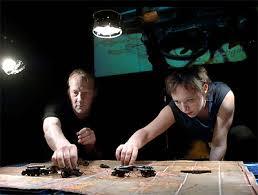Dutch performance group Hotel Modern, along with sound designer and composer Arthur Sauer, have created a fascinating, innovative and riveting miniature reenactment of World War I, using an imaginative mix of toy soldiers and tiny landscapes, along with a mélange of media and soundscape. The format of the performance is itself provocative, with the performers -- Herman Helle, Arlene Hoonweg and Pauline Kalker -- rapidly moving from set to set, manipulating the scenes with everything from mud and dishwashing soap to flames exploding from the mist of a can of WD-40. The use of mundane, everyday household materials extends the metaphor of the banality of war, as the troupe transforms miniature sets into scenes of profound horror, all captured by a handheld camera and projected onto a large screen.
The effect is cinematic in its scope, but yet intimate in scale, as the audience watches as the terrifying destruction and suffering of the war is literally constructed by hand before their eyes. This is truly a mixed-media experience, with all the high-tech tools of cinematography and sound design combined with the most primitive human instruments -- our hands -- to create a rich and moving experience. The event conjures the childhood experience of playing with toy soldiers or dolls and matches it with warfare on a global and unimaginably horrifying scale. The troupe also draws on currents in the visual arts by creating installation pieces that evoke emotions and responses from the viewer beyond the literal construction of piece.
While the performance succeeds beyond all measure in recreating the horror of the Great War, it is that very power which somewhat diminishes its impact. By focusing almost entirely on battlefield scenes of death and suffering, the performance becomes somewhat repetitive and inures us to the horror -- much like the real human experience of continual exposure to suffering. Their narrative also leaves out -- with the exception of a few scenes at the beginning -- the stupidity and callousness of the European politicians and generals who plunged the world into chaos. By adding this important dimension to the story, the creators might have avoided the numbing repetition of battlefield carnage and added a political perspective to their message. With that small criticism said, this is a powerful and important piece of theater that should not be missed.

